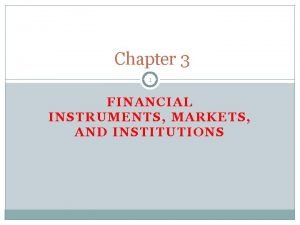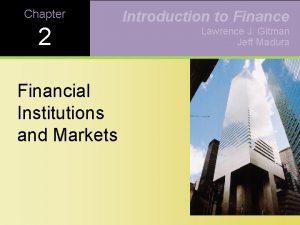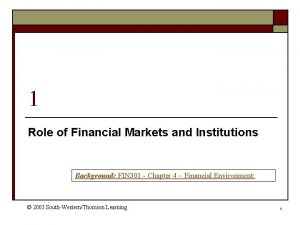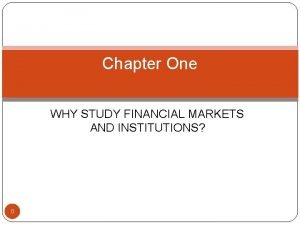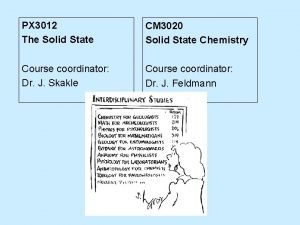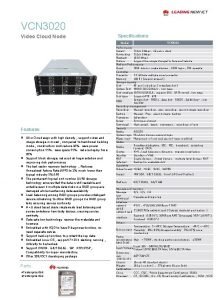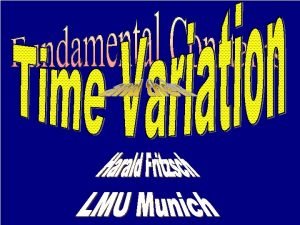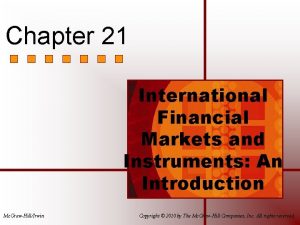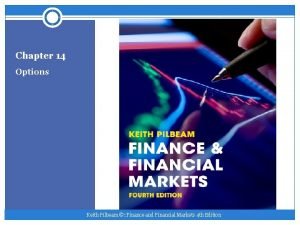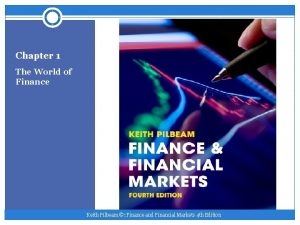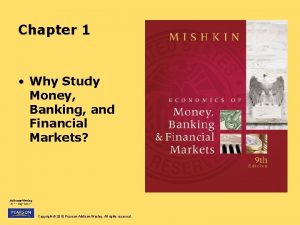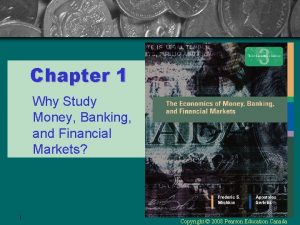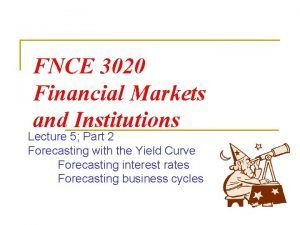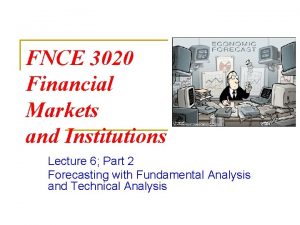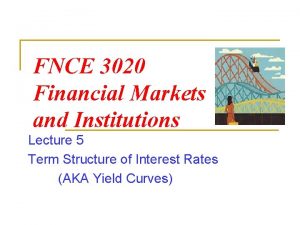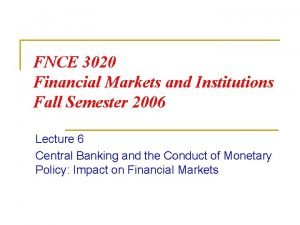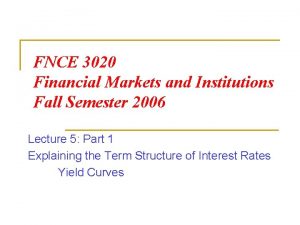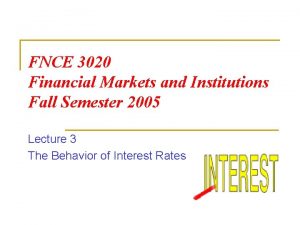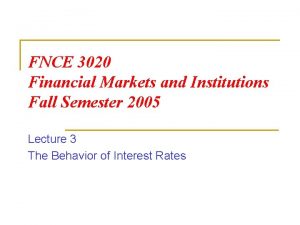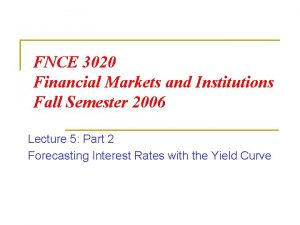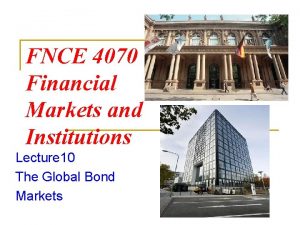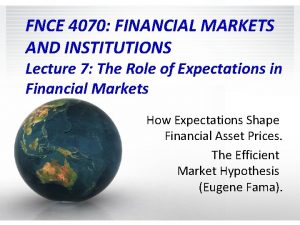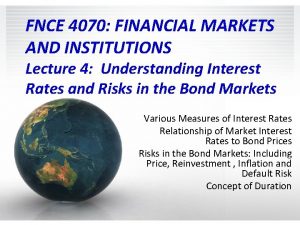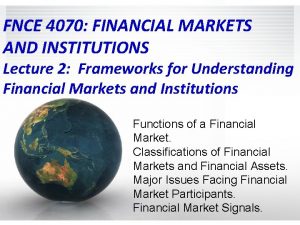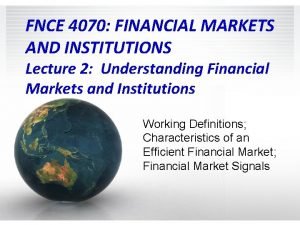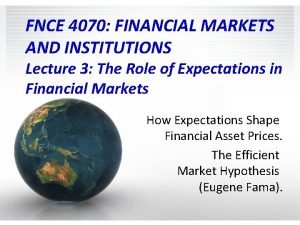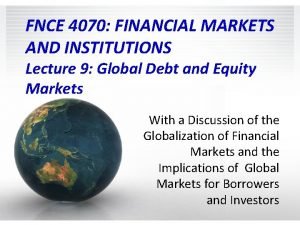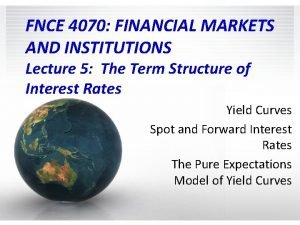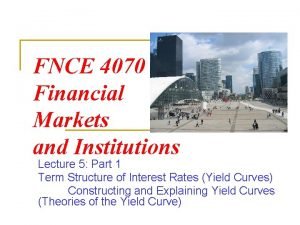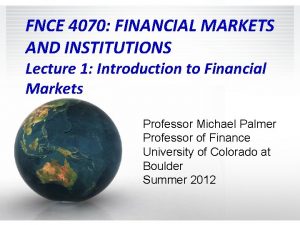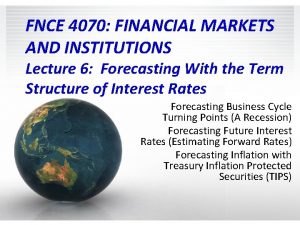FNCE 3020 Financial Markets and Institutions Lecture 6




























- Slides: 28

FNCE 3020 Financial Markets and Institutions Lecture 6; Part 2 Forecasting with Fundamental Analysis and Technical Analysis

Objective for This Lecture n To introduce you to two very different Series approaches to forecasting financial asset prices. q Fundamental analysis n n Uses economic and financial data upon which to base the calculation of the appropriate price of a financial asset. Tries to identify undervalued assets. q n Technical analysis Forecasting of future financial price movements based on an examination of past price (and volume) movements.

Forecasting Assuming Efficient Markets n n n According to the Efficient Market Hypothesis, when new information hits the market, the news spreads very quickly and is incorporated into asset prices without delay. If this the case, then any technique promising greater returns than the over-all market itself is questionable at best. So as we work through the following two forecasting approaches, we need to consider how efficient markets would impact upon each technique.

Fundamental Analysis n This technique attempts to identify “undervalued” financial assets, so that if purchased would enable the investor to achieve returns greater than those that could be obtained by holding a portfolio of the financial assets in question. q But, if markets are efficient, financial assets are priced correctly, i. e. , there will be no undervalued assets.

Fundamental Analysis: Selecting Appropriate Model n The selection of an appropriate “pricing” model is critical to the forecast for a particular financial asset. q Long-term Bonds n q Foreign Exchange (short term horizon) n q Short term interest rate differential models with focus on central bank policies Foreign Exchange (longer term horizon) n n q Interest rate models with focus on future inflation. Trade (imports and exports) and capital flows (stock market, foreign direct investment). Inflation. Common stock n Economic, industry and company models.

Fundamental Analysis: Common n Historically this is the approach most used by Stock financial analyst. q n Popularized by Columbia University Professors Benjamin Graham and David Dodd (1934, Security Analysis). n They argued that investors should buy stocks in corporations that have undervalued assets relative to their true market value, or n current assets exceeding current liabilities, n low price/earnings ratio. Graham and Dodd advocated searching out stocks which are undervalued by the market. n Once an undervalued security is found, it's simply a matter of buying the stock and waiting for the market to realize the "more accurate" value of that security.

Fundamental Analysis: Common q Fundamental approach has used successfully Stock by Warren Buffett who actually studied under Benjamin Graham at Columbia University in the early 1950 s. n q After graduation Buffett applied for a job with Graham investment firm, but was initially turned down! In April 3, 1995, Warren Buffett was quoted (Fortune Magazine) as follows “I'd be a bum in the street with a tin cup if the markets were efficient. “ n For an interesting account of Warren Buffett see: n http: //beginnersinvest. about. com/cs/warrenbuffett/a/aaw arrenbio. htm

Calculating the Value of Common Stock n n n There are two general approaches to valuing common equity: 1) the discounted cash flows approach, and 2) the relative valuation approach. Discounted Cash Flow: A stock’s value is based on the present value of its future cash flows, such as dividends. Relative Valuation Approach: Values a stock based on its current price relative to certain variables, such as the company's earnings, revenues or book value.

Top Down Fundamental Approach n This approach is probably the most comprehensive of all fundamental techniques. It can involve specific steps such as: q q 1. Economic Forecast (global, national, regional) 2. Group (Industry) Selection n q 3. Analysis of Companies within the Group n q Which industries are likely to do well in the forecasted environment. Leaders, innovators, start-ups, etc. 4. Company Selection n n Company’s Plans and Outlook New product development, red flags (litigation, etc. ) Management Financial Analysis

Technical Analysis n n This technique examines past financial asset prices in an attempt to predict future asset prices. However, if markets are efficient, then the quick flow of information will be immediately reflected in asset prices and tomorrow's price change will reflect only tomorrow’s news. q But, according to the efficient market hypothesis, tomorrow’s news is unpredictable and thus tomorrow’s price changes will be unpredictable and random.

Technical Analysis n History: Its origins can be traced to articles published by Charles H. Dow in the Wall Street Journal between 1900 and 1902. q q n Technical analysis believes that the price of an asset is determined by supply and demand. q n Dow suggested the use of “past price behavior to guide investing decisions. ” Technique became popular after contributions by Hamilton (1922) and Rhea (1932). Simply put, technical analysis uses charts which indicate the beginning of shifts in demand and/or supply – and thus lead price changes. Recall, technical analysis is at odds with the random walk assumption of the Efficient Market Hypothesis.

Definitions of Technical n Robert Edwards and John Magee’s classic book Analysis (Technical Analysis of Stock Trends, 1948): q n Technical Analysis is the science of recording, usually in graphic form, the actual history of trading (price changes, volume of transactions, etc. ) in a certain stock or in “the Averages” and then deducing from that pictured history the probable future trend. ” Martin J. Pring (Technical Analysis Explained, 1979). q "The technical approach to investing is essentially a reflection of the idea that prices move in trends which are determined by the changing attitudes of investors toward a variety of economic, monetary, political, and psychological forces. The art of technical analysis -- for it is an art -- is to identify trend changes at an early stage and to maintain an investment posture until the weight of the evidence indicates that the trend has reversed. "

Technical Analysis: Summary n Technical Analysis q This approach is NOT interested in financial or economic data that may affect the asset’s price. n q Utilizes charts of past price movements to estimate where prices may move in the future. n q q Sometimes referred to as a chartist (or charting) approach. Assumes prices are not random n q Sometimes referred to as “noise” trading (i. e. , not interested in news). That patterns of prices develop and can be used to forecast the future. Generally uses a short time frame: intraday (1 -minute, 5 -minutes, 10 -minutes, 15 -minutes, 30 -minutes or hourly), daily, weekly or monthly. Can be applied to any financial asset who’s price is determined by supply and demand. n Stock, bonds, foreign exchange, key commodities.

Examples of Technical n Moving Average Analysis of Stocks Approaches q Where is the individual stock (or market) in relation to some moving average of past prices? n n n If breaking above moving average, this is a signal of strength. If breaking below moving average, this is a signal of weakness. Overbought and Oversold Analysis of Stocks q Is the individual stock (or market) trading above or below its historical range? n Above its range suggests overbought condition. q n Below its range suggests oversold condition. q n A signal that the stock (or market) should move down. A signal that the stock (or market) should move up. Head and Shoulders Reversal Pattern of Stocks q Specific price and volume pattern which signals a reversal of the prior trend.

Moving Average: DJIA Over the Last 3 Months

Moving Average: Coca Cola Over the Last 3 Months

Overbought or Oversold: Level 3

Head and Shoulders Patterns n Head and shoulders is a reversal pattern that, when formed, signals the security is likely to move against its previous trend. q n n The signal appears to be most reliable (? ) in detecting a reversal of an uptrend. A Head and Shoulders pattern consists of four distinct parts: The left shoulder, the head, the right shoulder, and the neckline. Each of these four must be present for the formation to exist. In addition, the volume pattern must also meet strict requirements. Volume must show a peak on the left shoulder, a lower peak at the head, and then an even lower level at the right shoulder.

Head and Shoulder Formation n n Left Shoulder: A high volume rally and top followed by a minor reaction with significantly less volume than during the rise and top. Head: Another high volume rally with the top reaching a higher level than the left shoulder, followed by a another reaction on less volume that takes the price to a level near the bottom of the previous reaction. Right Shoulder: A third rally on noticeably less volume that fails to reach the top of the head. Neckline: A decline in prices from the top of the right shoulder which falls below the line formed when connecting the bottoms of the left shoulder and head by at least 23% of the stock's market value. n Head and Shoulders as a Reversal Pattern in an Uptrend

Head and Shoulders as a Reversal Signal in an Uptrend: Diagnostics Products, November 2001

Use of Technical Analysis in Foreign Exchange Markets n n n During the last 15 years or so – beginning with joint research by Mark P. Taylor and Helen Allen (1990, 1992) – a number of studies have reported the results of surveys of foreign exchange market participants in the major trading centers concerning the use of technical analysis. These studies concluded that technical analysis is in widespread use among foreign exchange professionals. As early examples see: q q Allen, Helen, and Mark P. Taylor. 1990. "Charts, Noise and Fundamentals in the London Foreign Exchange Market. " Economic Journal 100 (supplement): 49 -59. Taylor, Mark P. , and Helen Allen. 1992. "The Use of Technical Analysis in the Foreign Exchange Market. " Journal of International Money and Finance 11: 304 -14.

Technical Analysis: Foreign Exchange

Source of Technical Charts n For a discussion of types of technical signals see: q http: //www. tradetrek. com/education/tech_trading_strategy 03. asp n Data for individual stocks: q http: //finance. yahoo. com/q? s=goog n For charts of individual stocks and the market: q http: //finance. yahoo. com/q/bc? s=goog&t=1 d n For interactive charts of individual stocks and the market: q http: //finance. yahoo. com/charts#chart 1: symbol=goog; range=1 d; i ndicator=volume; charttype=line; crosshair=on; logscale=off; source = n Data for U. S. market and overseas markets q http: //finance. yahoo. com/intlindices? u

Appendix 1 Interview with Benjamin Graham

Interview with Graham in the 1970 s n n Question: In selecting the common stock portfolio, do you advise careful study of and selectivity among different issues? Graham: In general, no. I am no longer an advocate of elaborate techniques of security analysis in order to find superior value opportunities. This was a rewarding activity, say, 40 years ago, when our textbook “Graham and Dodd” was first published; but the situation has changed a great deal since then. In the old days any well-trained security analyst could do a good professional job of selecting undervalued issues through detailed studies; but in the light of the enormous amount of research now being carried on, I doubt whether in most cases such extensive efforts will generate sufficiently superior selections to justify their cost. To that very limited extent I’m on the side of the “efficient market” school of thought now generally accepted by the professors.

Appendix 2: Three Forms of Market Efficiency and Forecasting The following two slides discuss (1) the three forms of market efficiency and (2) the use of forecasting with these three forms.

Three Forms of The Efficient Market Hypothesis n There actually three stages of the EMH model: q q q Weak Form: Current prices reflect all past price and past volume information. n The fundamental information contained in the past sequence of prices of a security is fully reflected in the current market price of that security. Semi-strong Form: Current prices reflect all past price and past volume information AND all publicly available information. n Information such as interest rates, earnings, inflation, etc. Strong Form: Current prices reflect all past price and past volume information, all publicly available information AND all private (e. g. , insider) information.

Forecasting asset prices within the 3 Types of Efficient Markets: n Weak form: In this type of a market, all past data and prices are reflected in the current prices. q n Semi strong form: In this type of a market, all public information is reflected in the current stock prices. q n Thus, Technical Analysis is not of any use. Thus, here, even Fundamental Analysis is of no use (as well as technical analysis) Strong form: In this type of market, all information is reflected in the current stock prices. q Thus, not only is any kind of analysis useless, even insider information is useless for predicting future stock market prices.
 Financial markets and institutions - ppt
Financial markets and institutions - ppt Why study financial markets and institutions?
Why study financial markets and institutions? Participants in money market
Participants in money market Basic flow of funds through the financial system
Basic flow of funds through the financial system Madura j. financial markets and institutions
Madura j. financial markets and institutions Equity securities
Equity securities Madura j. financial markets and institutions
Madura j. financial markets and institutions Why study financial markets and institutions
Why study financial markets and institutions Chapter 12 money and financial institutions
Chapter 12 money and financial institutions Chapter 12 money and financial institutions
Chapter 12 money and financial institutions Px3012
Px3012 Mil-std-3020
Mil-std-3020 Da form 1804
Da form 1804 Vcn3020
Vcn3020 Solid
Solid Fine structure constant
Fine structure constant The financial system
The financial system International financial markets and instruments
International financial markets and instruments Capital markets and financial intermediation
Capital markets and financial intermediation Primary and secondary financial markets
Primary and secondary financial markets Financial markets and the allocation of capital
Financial markets and the allocation of capital Foreign exchange and international financial markets
Foreign exchange and international financial markets Pilbeam k. finance and financial markets
Pilbeam k. finance and financial markets Keith pilbeam
Keith pilbeam Chapter 6 consumers savers and investors answer key
Chapter 6 consumers savers and investors answer key Why study money banking and financial markets
Why study money banking and financial markets Why study money banking and financial markets
Why study money banking and financial markets Functions of financial institutions
Functions of financial institutions Management of financial institutions daibb pdf
Management of financial institutions daibb pdf



